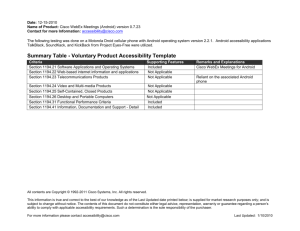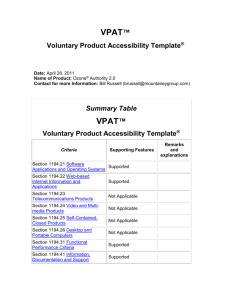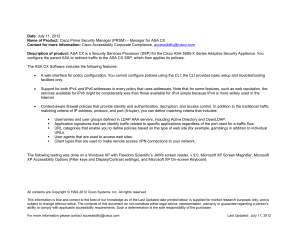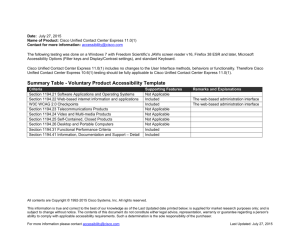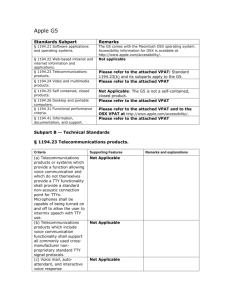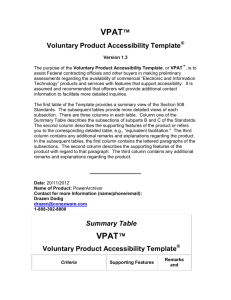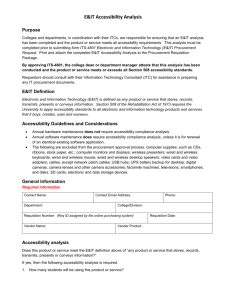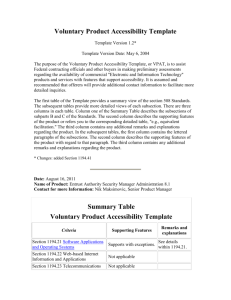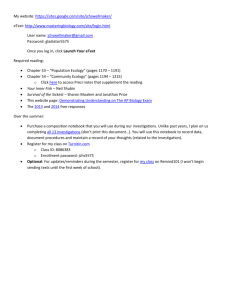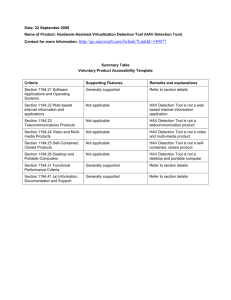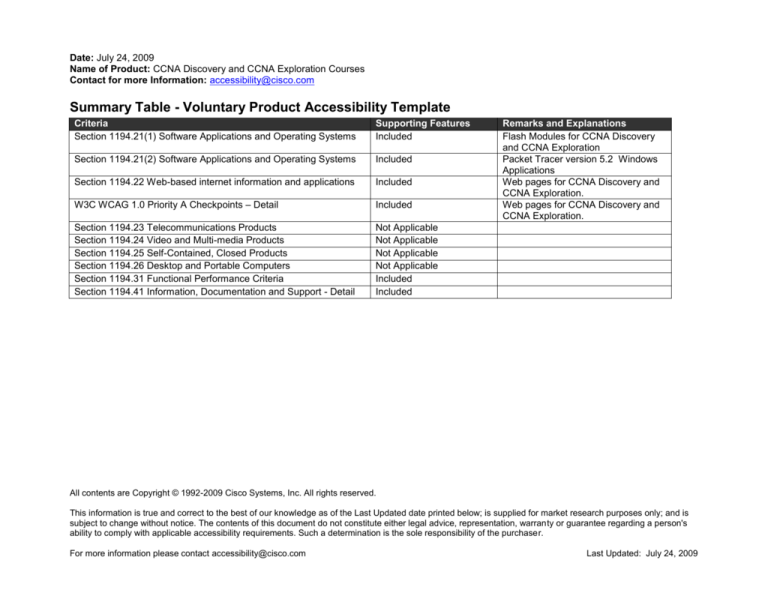
Date: July 24, 2009
Name of Product: CCNA Discovery and CCNA Exploration Courses
Contact for more Information: accessibility@cisco.com
Summary Table - Voluntary Product Accessibility Template
Criteria
Section 1194.21(1) Software Applications and Operating Systems
Supporting Features
Included
Section 1194.21(2) Software Applications and Operating Systems
Included
Section 1194.22 Web-based internet information and applications
Included
W3C WCAG 1.0 Priority A Checkpoints – Detail
Included
Section 1194.23 Telecommunications Products
Section 1194.24 Video and Multi-media Products
Section 1194.25 Self-Contained, Closed Products
Section 1194.26 Desktop and Portable Computers
Section 1194.31 Functional Performance Criteria
Section 1194.41 Information, Documentation and Support - Detail
Not Applicable
Not Applicable
Not Applicable
Not Applicable
Included
Included
Remarks and Explanations
Flash Modules for CCNA Discovery
and CCNA Exploration
Packet Tracer version 5.2 Windows
Applications
Web pages for CCNA Discovery and
CCNA Exploration.
Web pages for CCNA Discovery and
CCNA Exploration.
All contents are Copyright © 1992-2009 Cisco Systems, Inc. All rights reserved.
This information is true and correct to the best of our knowledge as of the Last Updated date printed below; is supplied for market research purposes only; and is
subject to change without notice. The contents of this document do not constitute either legal advice, representation, warranty or guarantee regarding a person's
ability to comply with applicable accessibility requirements. Such a determination is the sole responsibility of the purchaser.
For more information please contact accessibility@cisco.com
Last Updated: July 24, 2009
Section 1194.21(1): Software Applications and Operating Systems – Detail
Flash Modules for Discovery and Exploration
508 Clause
Criteria
Supporting Features
1194.21(a)
When software is designed to run on a system that has a
keyboard, product functions shall be executable from a
keyboard where the function itself or the result of performing
a function can be discerned textually.
Does Not Support
1194.21(b)
Applications shall not disrupt or disable activated features of
other products that are identified as accessibility features,
where those features are developed and documented
according to industry standards. Applications also shall not
disrupt or disable activated features of any operating system
that are identified as accessibility features where the
application programming interface for those accessibility
features has been documented by the manufacturer of the
operating system and is available to the product developer.
A well-defined on-screen indication of the current focus shall
be provided that moves among interactive interface elements
as the input focus changes. The focus shall be
programmatically exposed so that Assistive Technology can
track focus and focus changes.
Sufficient information about a user interface element
including the identity, operation and state of the element
shall be available to Assistive Technology. When an image
represents a program element, the information conveyed by
the image must also be available in text.
Does Not Support
When bitmap images are used to identify controls, status
indicators, or other programmatic elements, the meaning
assigned to those images shall be consistent throughout an
application's performance.
Does Not Support
1194.21(c)
1194.21(d)
1194.21(e)
Remarks and
Explanations
Does Not Support
Does Not Support
All contents are Copyright © 1992-2009 Cisco Systems, Inc. All rights reserved.
This information is true and correct to the best of our knowledge as of the Last Updated date printed below; is supplied for market research purposes only; and is
subject to change without notice. The contents of this document do not constitute either legal advice, representation, warranty or guarantee regarding a person's
ability to comply with applicable accessibility requirements. Such a determination is the sole responsibility of the purchaser.
For more information please contact accessibility@cisco.com
Last Updated: July 24, 2009
1194.21(f)
Textual information shall be provided through operating
system functions for displaying text. The minimum
information that shall be made available is text content, text
input caret location, and text attributes.
Does Not Support
1194.21(g)
Applications shall not override user selected contrast and
color selections and other individual display attributes.
When animation is displayed, the information shall be
displayable in at least one non-animated presentation mode
at the option of the user.
Does Not Support
1194.21(i)
Color coding shall not be used as the only means of
conveying information, indicating an action, prompting a
response, or distinguishing a visual element.
Supports
1194.21(j)
When a product permits a user to adjust color and contrast
settings, a variety of color selections capable of producing a
range of contrast levels shall be provided.
Not Applicable
1194.21(k)
Software shall not use flashing or blinking text, objects, or
other elements having a flash or blink frequency greater than
2 Hz and lower than 55 Hz.
Supports
1194.21(l)
When electronic forms are used, the form shall allow people
using Assistive Technology to access the information, field
elements, and functionality required for completion and
submission of the form, including all directions and cues.
Does Not Support
1194.21(h)
Does Not Support
All contents are Copyright © 1992-2009 Cisco Systems, Inc. All rights reserved.
This information is true and correct to the best of our knowledge as of the Last Updated date printed below; is supplied for market research purposes only; and is
subject to change without notice. The contents of this document do not constitute either legal advice, representation, warranty or guarantee regarding a person's
ability to comply with applicable accessibility requirements. Such a determination is the sole responsibility of the purchaser.
For more information please contact accessibility@cisco.com
Last Updated: July 24, 2009
Section 1194.21(2): Software Applications and Operating Systems – Detail
CCNA Packet Tracer, version 5.2
508 Clause
Criteria
1194.21(a)
When software is designed to run on a system that
has a keyboard, product functions shall be
executable from a keyboard where the function
itself or the result of performing a function can be
discerned textually.
1194.21(b)
1194.21(c)
1194.21(d)
Applications shall not disrupt or disable activated
features of other products that are identified as
accessibility features, where those features are
developed and documented according to industry
standards. Applications also shall not disrupt or
disable activated features of any operating system
that are identified as accessibility features where
the application programming interface for those
accessibility features has been documented by the
manufacturer of the operating system and is
available to the product developer.
A well-defined on-screen indication of the current
focus shall be provided that moves among
interactive interface elements as the input focus
changes. The focus shall be programmatically
exposed so that Assistive Technology can track
focus and focus changes.
Sufficient information about a user interface
element including the identity, operation and state
of the element shall be available to Assistive
Technology. When an image represents a
program element, the information conveyed by the
image must also be available in text.
Supporting Features
Supports with Exceptions
Remarks and Explanations
The product does provide keyboard
navigation within its framework, i.e.
menus, dialogs, and other GUI
elements. A list of keyboard
shortcuts for the product can be
obtained through the following
pathway:
Supports
Product supports OS accessibility
features such as Sticky Keys and
Filter keys.
Supports
Supported with Exceptions
Product uses images in the Logical
and Physical views that are not
identified by assistive technology.
All contents are Copyright © 1992-2009 Cisco Systems, Inc. All rights reserved.
This information is true and correct to the best of our knowledge as of the Last Updated date printed below; is supplied for market research purposes only; and is
subject to change without notice. The contents of this document do not constitute either legal advice, representation, warranty or guarantee regarding a person's
ability to comply with applicable accessibility requirements. Such a determination is the sole responsibility of the purchaser.
For more information please contact accessibility@cisco.com
Last Updated: July 24, 2009
1194.21(e)
1194.21(f)
1194.21(g)
1194.21(h)
1194.21(i)
1194.21(j)
1194.21(k)
1194.21(l)
When bitmap images are used to identify controls,
status indicators, or other programmatic elements,
the meaning assigned to those images shall be
consistent throughout an application's
performance.
Textual information shall be provided through
operating system functions for displaying text. The
minimum information that shall be made available
is text content, text input caret location, and text
attributes.
Applications shall not override user selected
contrast and color selections and other individual
display attributes.
When animation is displayed, the information shall
be displayable in at least one non-animated
presentation mode at the option of the user.
Supports with Exceptions
Color coding shall not be used as the only means
of conveying information, indicating an action,
prompting a response, or distinguishing a visual
element.
When a product permits a user to adjust color and
contrast settings, a variety of color selections
capable of producing a range of contrast levels
shall be provided.
Software shall not use flashing or blinking text,
objects, or other elements having a flash or blink
frequency greater than 2 Hz and lower than 55 Hz.
Supports
When electronic forms are used, the form shall
allow people using Assistive Technology to access
the information, field elements, and functionality
required for completion and submission of the
Product uses images in the Logical
and Physical views that are not
identified by assistive technology.
Supports
Does Not Support
Does Not Support
Product does not inherit the OS
Display setting for High Contrast
and Text Size.
The Simulation view utilizes
animations to simulate a Network
and does not provide an alternative
accessible presentation mode.
Not Applicable
Supports
Supports with Exceptions
Product does not have blinking or
flashing objects that are within the
danger range of 2 Hz to 55 Hz.
Additionally, the flash/blink
instances only occur in
approximately less than 10% of the
computer screen.
Dialogs and settings invoked in the
Logical and Physical views rely on
the mouse to access.
All contents are Copyright © 1992-2009 Cisco Systems, Inc. All rights reserved.
This information is true and correct to the best of our knowledge as of the Last Updated date printed below; is supplied for market research purposes only; and is
subject to change without notice. The contents of this document do not constitute either legal advice, representation, warranty or guarantee regarding a person's
ability to comply with applicable accessibility requirements. Such a determination is the sole responsibility of the purchaser.
For more information please contact accessibility@cisco.com
Last Updated: July 24, 2009
form, including all directions and cues.
The product does provide keyboard
navigation within its framework, i.e.
menus, dialogs, and other GUI
elements, but does not fully support
keyboard navigation for critical
tasks.
All contents are Copyright © 1992-2009 Cisco Systems, Inc. All rights reserved.
This information is true and correct to the best of our knowledge as of the Last Updated date printed below; is supplied for market research purposes only; and is
subject to change without notice. The contents of this document do not constitute either legal advice, representation, warranty or guarantee regarding a person's
ability to comply with applicable accessibility requirements. Such a determination is the sole responsibility of the purchaser.
For more information please contact accessibility@cisco.com
Last Updated: July 24, 2009
Section 1194.22 Web-based internet information and applications – Detail
CCNA Discovery and Exploration Web
508 Clause
Criteria
1194.22(a)
Status
A text equivalent for every non-text element shall be
provided (e.g., via "alt", "longdesc", or in element content).
Equivalent alternatives for any multimedia presentation shall
be synchronized with the presentation.
Supports
1194.22(c)
Web pages shall be designed so that all information
conveyed with color is also available without color, for
example from context or markup.
Supports
1194.22(d)
Documents shall be organized so they are readable without
requiring an associated style sheet.
Redundant text links shall be provided for each active region
of a server-side image map.
Client-side image maps shall be provided instead of serverside image maps except where the regions cannot be
defined with an available geometric shape.
Supports
1194.22(g)
1194.22(h)
Row and column headers shall be identified for data tables.
Markup shall be used to associate data cells and header
cells for data tables that have two or more logical levels of
row or column headers.
Supports
Not Applicable
1194.22(i)
Frames shall be titled with text that facilitates frame
identification and navigation.
Pages shall be designed to avoid causing the screen to
flicker with a frequency greater than 2 Hz and lower than 55
Hz.
Supports
1194.22(b)
1194.22(e)
1194.22(f)
1194.22(j)
Supports
Not Applicable
Not Applicable
Remarks and
Explanations
The Flash multimedia
modules for the following
courses have text
equivalents. Discovery 1,
Discovery (1,2, 3 and 4)
and Exploration (1, 2, 3 and
4).
Product does not use
server-side image maps.
Product does not use clientside image maps.
Product does not use
complex data tables with
two or more logical levels.
Supports
All contents are Copyright © 1992-2009 Cisco Systems, Inc. All rights reserved.
This information is true and correct to the best of our knowledge as of the Last Updated date printed below; is supplied for market research purposes only; and is
subject to change without notice. The contents of this document do not constitute either legal advice, representation, warranty or guarantee regarding a person's
ability to comply with applicable accessibility requirements. Such a determination is the sole responsibility of the purchaser.
For more information please contact accessibility@cisco.com
Last Updated: July 24, 2009
1194.22(k)
A text-only page, with equivalent information or functionality,
shall be provided to make a web site comply with the
provisions of this part, when compliance cannot be
accomplished in any other way. The content of the text-only
page shall be updated whenever the primary page changes.
Not Applicable
1194.22(l)
When pages utilize scripting languages to display content,
or to create interface elements, the information provided by
the script shall be identified with functional text that can be
read by assistive technology.
Supports
1194.22(m)
When a web page requires that an applet, plug-in or other
application be present on the client system to interpret page
content, the page must provide a link to a plug-in or applet
that complies with §1194.21(a) through (l).
Supports
1194.22(n)
When electronic forms are designed to be completed online, the form shall allow people using assistive technology
to access the information, field elements, and functionality
required for completion and submission of the form,
including all directions and cues.
Supports
1194.22(o)
A method shall be provided that permits users to skip
repetitive navigation links.
When a timed response is required, the user shall be alerted
and given sufficient time to indicate more time is required.
Supports
1194.22(p)
Product provides fully
accessible web framework
and content.
Not Applicable
All contents are Copyright © 1992-2009 Cisco Systems, Inc. All rights reserved.
This information is true and correct to the best of our knowledge as of the Last Updated date printed below; is supplied for market research purposes only; and is
subject to change without notice. The contents of this document do not constitute either legal advice, representation, warranty or guarantee regarding a person's
ability to comply with applicable accessibility requirements. Such a determination is the sole responsibility of the purchaser.
For more information please contact accessibility@cisco.com
Last Updated: July 24, 2009
W3C WCAG 1.0 Priority A Checkpoints – Detail
CCNA Discovery and Exploration Web
Checkpoints
In General (Priority 1)
Supporting Features
1.1 Provide a text equivalent for every non-text element (e.g., via "alt",
"longdesc", or in element content). This includes: images, graphical
representations of text (including symbols), image map regions, animations
(e.g., animated GIFs), applets and programmatic objects, ascii art, frames,
scripts, images used as list bullets, spacers, graphical buttons, sounds (played
with or without user interaction), stand-alone audio files, audio tracks of video,
and video.
2.1 Ensure that all information conveyed with color is also available without
color, for example from context or markup.
4.1 Clearly identify changes in the natural language of a document's text and
any text equivalents (e.g., captions).
6.1 Organize documents so they may be read without style sheets. For
example, when an HTML document is rendered without associated style
sheets, it must still be possible to read the document.
Supports
6.2 Ensure that equivalents for dynamic content are updated when the
dynamic content changes.
7.1 Until user agents allow users to control flickering, avoid causing the screen
to flicker.
14.1 Use the clearest and simplest language appropriate for a site's content.
And if you use images and image maps (Priority 1)
1.2 Provide redundant text links for each active region of a server-side image
map.
9.1 Provide client-side image maps instead of server-side image maps except
where the regions cannot be defined with an available geometric shape.
And if you use tables (Priority 1)
5.1 For data tables, identify row and column headers.
5.2 For data tables that have two or more logical levels of row or column
headers, use markup to associate data cells and header cells.
And if you use frames (Priority 1)
Supports
Comments
Supports
Supports
Supports
Supports
Supports
Not Applicable
Not Applicable
Supports
Not Applicable
All contents are Copyright © 1992-2009 Cisco Systems, Inc. All rights reserved.
This information is true and correct to the best of our knowledge as of the Last Updated date printed below; is supplied for market research purposes only; and is
subject to change without notice. The contents of this document do not constitute either legal advice, representation, warranty or guarantee regarding a person's
ability to comply with applicable accessibility requirements. Such a determination is the sole responsibility of the purchaser.
For more information please contact accessibility@cisco.com
Last Updated: July 24, 2009
12.1 Title each frame to facilitate frame identification and navigation.
And if you use applets and scripts (Priority 1)
6.3 Ensure that pages are usable when scripts, applets, or other programmatic
objects are turned off or not supported. If this is not possible, provide
equivalent information on an alternative accessible page.
Supports
Supports
And if you use multimedia (Priority 1)
1.3 Until user agents can automatically read aloud the text equivalent of a
visual track, provide an auditory description of the important information of the
visual track of a multimedia presentation.
Supports
1.4 For any time-based multimedia presentation (e.g., a movie or animation),
synchronize equivalent alternatives (e.g., captions or auditory descriptions of
the visual track) with the presentation.
Supports
The Flash multimedia modules for the
following courses have text equivalents.
Discovery (1, 2, 3 and 4) and
Exploration (1, 2, 3 and 4).
All contents are Copyright © 1992-2009 Cisco Systems, Inc. All rights reserved.
This information is true and correct to the best of our knowledge as of the Last Updated date printed below; is supplied for market research purposes only; and is
subject to change without notice. The contents of this document do not constitute either legal advice, representation, warranty or guarantee regarding a person's
ability to comply with applicable accessibility requirements. Such a determination is the sole responsibility of the purchaser.
For more information please contact accessibility@cisco.com
Last Updated: July 24, 2009
Section 1194.31: Functional Performance Criteria - Detail
508 Clause
Criteria
Supporting Features
1194.31(a)
At least one mode of operation and information retrieval that
does not require user vision shall be provided, or support for
Assistive Technology used by people who are blind or visually
impaired shall be provided.
Supports with
Exceptions
1194.31(b)
At least one mode of operation and information retrieval that
does not require visual acuity greater than 20/70 shall be
provided in audio and enlarged print output working together
or independently, or support for Assistive Technology used by
people who are visually impaired shall be provided.
Supports with
Exceptions
Remarks and
Explanations
Hardware pods with in
Academies provide an
accessible equivalent to the
Packet Tracer simulation
tool and its accessibility
issues indicated in
1194.21(2).
The Flash multimedia
modules for the following
courses have text
equivalents. Discovery (1,
2, 3 and 4) and Exploration
(1, 2, 3 and 4).
The CCNA web curricula
provides accessible
alternative to the Flash
curricula and its
accessibility issues
provided in 1194.21(1) in
this document.
Hardware pods with in
Academies provide an
accessible equivalent to the
Packet Tracer simulation
tool and its accessibility
issues indicated in
1194.21(2).
1194.31(c)
At least one mode of operation and information retrieval that
does not require user hearing shall be provided, or support for
Assistive Technology used by people who are deaf or hard of
hearing shall be provided.
Supports
All contents are Copyright © 1992-2009 Cisco Systems, Inc. All rights reserved.
This information is true and correct to the best of our knowledge as of the Last Updated date printed below; is supplied for market research purposes only; and is
subject to change without notice. The contents of this document do not constitute either legal advice, representation, warranty or guarantee regarding a person's
ability to comply with applicable accessibility requirements. Such a determination is the sole responsibility of the purchaser.
For more information please contact accessibility@cisco.com
Last Updated: July 24, 2009
1194.31(d)
1194.31(e)
1194.31(f)
Where audio information is important for the use of a product,
at least one mode of operation and information retrieval shall
be provided in an enhanced auditory fashion, or support for
assistive hearing devices shall be provided.
At least one mode of operation and information retrieval that
does not require user speech shall be provided, or support for
Assistive Technology used by people with disabilities shall be
provided.
At least one mode of operation and information retrieval that
does not require fine motor control or simultaneous actions
and that is operable with limited reach and strength shall be
provided.
Not Applicable
Supports
Supports with
Exceptions
Hardware pods with in
Academies provide an
accessible equivalent to the
Packet Tracer simulation
tool and its accessibility
issues indicated in
1194.21(2).
All contents are Copyright © 1992-2009 Cisco Systems, Inc. All rights reserved.
This information is true and correct to the best of our knowledge as of the Last Updated date printed below; is supplied for market research purposes only; and is
subject to change without notice. The contents of this document do not constitute either legal advice, representation, warranty or guarantee regarding a person's
ability to comply with applicable accessibility requirements. Such a determination is the sole responsibility of the purchaser.
For more information please contact accessibility@cisco.com
Last Updated: July 24, 2009
Section 1194.41: Information, Documentation and Support
508 Clause
Criteria
Supporting Features
1194.41(a)
Product support documentation provided to end-users shall be
made available in alternate formats upon request, at no
additional charge
Supports
1194.41(b)
End-users shall have access to a description of the
accessibility and compatibility features of products in alternate
formats or alternate methods upon request, at no additional
charge.
Supports
1194.41(c)
Support services for products shall accommodate the
communication needs of end-users with disabilities.
Supports
Remarks and
Explanations
Accessible documentation is
available through Cisco
Technical Assistance Center
(TAC) upon request.
Accessible documentation is
available through Cisco
Technical Assistance Center
(TAC) upon request.
Pathway to the Packet
Tracer keyboard shortcuts.
Cisco conforms through
equal facilitation.
Customers may reach Cisco
Technical Assistance Center
(TAC) via Phone, Email or
Web Form. All cases open
through email or web are
opened as Priority 3 cases.
All Priority 1 or Priority 2
case can only be opened via
the telephone. TTY users
must call the Text Relay
Service (TRS) by dialing
711 and have the TRS
agent contact Cisco TAC via
voice.
All contents are Copyright © 1992-2009 Cisco Systems, Inc. All rights reserved.
This information is true and correct to the best of our knowledge as of the Last Updated date printed below; is supplied for market research purposes only; and is
subject to change without notice. The contents of this document do not constitute either legal advice, representation, warranty or guarantee regarding a person's
ability to comply with applicable accessibility requirements. Such a determination is the sole responsibility of the purchaser.
For more information please contact accessibility@cisco.com
Last Updated: July 24,2009

